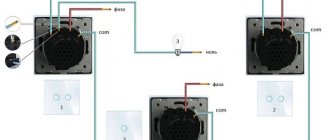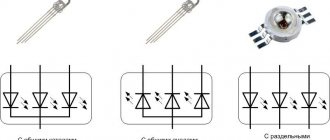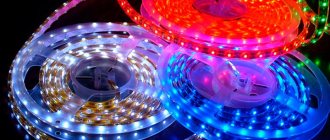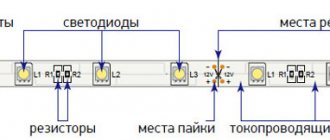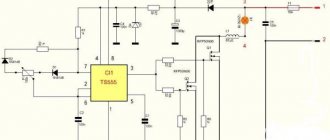About the design of an LED strip with a touch switch: pros, cons. We assemble an LED strip with a touch switch ourselves. 5 questions you need to understand. + TEST for self-test
TEST:
4 questions to test your knowledge
- What is the assembly formed from?
A. Tape.
B. Switch.
B. Wiring.
G. Nutrition.
- What type of button is right for the switch?
A. Infrared.
B. Dimmer.
B. Sensory.
G. The most common one.
- Adapter power supply.
A. 12 W.
B. 16 W.
V. 18 W.
G. 5 W.
- Why do you need a plastic profile?
A. Beauty.
B. Ease of installation.
B. Security of the system.
G. Not needed at all.
Modern interior solutions often use electrics with motion sensors. It would be more correct to call them touch radio switches. Let us consider in detail the advantages, areas for proper use and much more.
More about LED strip (hereinafter referred to as S.L.): 3 main points
The tape can be either ready-made or homemade. Its types:
- Invoice. Variety - linear. Can be purchased as a set or individually. In the set, the modules are connected into one complex by a special adapter.
- Invoice. Variety - dotted. Look at the picture:
Invoice.
Variety - dotted. Today you can buy items 1 and 2, which already have touch switches built into them. It is enough to lightly touch their body in a certain area to turn the light on or off.
Touch sensor
The touch sensor usually appears as a constantly lit blue LED.
- Mortise tape. It can also be linear or pointwise. A good advantage is the thickness. Installation of the mortise strip usually occurs in the lower shelf of the cabinet towards the lower surface.
This type of lighting fits entirely into the bottom shelf. Installation requires certain skills.
Touch switches (S.V.): 1 switch for everything
Switches of this type have not been on the market for long, but have already become very popular. Often the touch switch already comes in a duo with a ribbon.
First you need to find out what a sensor is. Its appearance is a panel made of crystals. There is a special marking on it. Household versions are designed for a 220 V system.
Such devices are excellent solutions for installing in the kitchen using LED strips. This way the functional surface is illuminated powerfully and efficiently. A switch attached to the strip greatly facilitates work in the evening and at night. But for problem areas, the following remote control was invented:
Remote controller
You can connect sconces to such a switch. It also helps control lighting in multi-tiered ceilings. Of course, if a ribbon with one color or a multi-colored palette is used. This system is convenient to control using the remote control.
No matter how the switch is used, it should be borne in mind that the connection plan may be different.
Some changes appear in the circuit when the remote control is used.
A touch switch is easy to purchase in a store, but you can create it yourself. Self-installation of such a switch is not difficult. Work can be carried out in the kitchen or in another room. For installation in the kitchen, an aluminum profile should be used.
Connection and installation
How are they connected? Let's look at an example of an almost finished backlight. Let's say we have an aluminum profile with a soft LED strip inside.
First, remove the cap and diffuser.
To get to the strands, cut away the heat shrink. Ready-made LED lighting kits, they are already equipped with soldered wires and an output connector.
Since the switch module takes up a certain space, a piece of tape will need to be cut.
Next we move on to welding work.
Choose a low-power soldering iron (up to 40W) and solder the wires.
Now you need to position the module correctly. Which wires should I connect them to?
Look for clues and corresponding labels on the back. For example:
- GND (-) and VCC (+) are the main power supply of the device
- Led (-) and led (+) - output to load
If there are no entries or they have been deleted, proceed as follows. The contacts remote from the button are powered by a voltage of 12-24 V, and those close to it go to the tape itself.
With this arrangement of the module (photo above), the lower contacts will be negative and the upper contacts will be positive.
First, solder the wires from the power supply.
After this, be sure to insulate the connections with shrink film to prevent accidental short circuits inside the aluminum profile with its body.
Then an ice ribbon is connected to veins with a cross-section of 0.5-0.75 mm2. Just don't confuse more and less.
It is often necessary to make a cross connection to maintain polarity.
These wires are also necessarily insulated. The switch module itself is glued to the surface of the box with double-sided tape.
Additional sensor functionality: 5 important points
This device has a variety of activations. It may also have additional features. With certain skills, a homemade sensor can be equipped with a good range of functions. Today, similar switches are produced with the following versions of added functions:
- Remote control. It greatly facilitates control over the light spectrum of multi-color tape. In this case, the use of a controller is mandatory. Otherwise the remote control will not work. The remote control is also good at controlling sconces. And when connecting to a tape, the remote control must be selected in tandem with the controller.
- Timer. Thanks to this device, significant energy savings can be achieved. In the timer, you can set the time to turn off the lights when there are no people in the room or in the house.
- Volume response. This product reacts even to light contact. Often this device is made independently and complements the timer.
- View without contact. The reaction of these devices occurs when the situation in the room somehow changes. These may be different movements, temperature and lighting changes.
- Dimmer. Any designated touch strip devices can be equipped with a dimmer. This addition allows you to control the brightness of the light in the room.
Optimal for a residential apartment is 1 netxt LED lamp with a touch switch. But it is not prohibited to work on modern electrics with your own hands. More on this below.
Single color
Connecting a single-color LED strip is not difficult. All you need is to purchase the components of the backlight, cut the required length of LED strip, solder it to the power supply and insulate the exposed contacts. Now we will consider in detail each of the connection stages.
Selecting a connection diagram
To independently connect an LED strip to a 220 volt network, you must first select a diagram for connecting all the elements. If you decide to make lighting using no more than 5 meters of product, then just connect the strip to a 220 x 12 V power supply, and connect the power supply to your home network via a cord with a plug.
However, it often happens that you need to connect more than 5 meters of LED strip - 10, 15 or even 20 meters. In this case, it is prohibited to connect all segments sequentially, because the first 5-meter section will overheat and at the same time the voltage in subsequent sections will drop significantly. Such a connection will shorten the life of the LED backlight. We examined all the most popular LED strip connection diagrams in detail in the corresponding article. For example, let's provide them again.
Consecutively (allowed if you need to add a small segment):
With two power supplies (if the tape is long):
Please note that you can connect the LED strip via a switch or dimmer, which is very convenient when creating additional lighting in the kitchen or other room. In this case, the light switch is connected in front of the power supply in a phase break, as shown in the diagram below:
The dimmer must be connected after the power supply, as shown in this example:
We’ve sorted out the diagrams for connecting LEDs to a 220v network, now let’s move on to the process of connecting the circuit elements.
Connecting components
In the simplest example, we have a 220/12v power supply and 5 meters of single-color LED strip. To connect all elements to 220 volts, you need to perform the following steps:
- Cut the appropriate length of the product. We have already talked about how to properly cut LED strip. The conductor must be cut in strictly designated areas, indicated by a dotted line or a scissors icon, as shown in the photo below:
- Prepare wires for connection. If the length is no more than 5 meters, you can safely choose a wire with a cross-section of 1.5 mm 2. If the tape is long, we recommend calculating the wire cross-section by power and current in order to select the appropriate value.
- Prepare a soldering iron, rosin and solder.
- Degrease the contact pads of the LED conductor using cotton wool and alcohol.
- Strip the wires for connecting the product by 2-3 mm for soldering.
- Tin the wires and pads for soldering.
- Solder the wires to the LED strip. It is best to use tin-lead solder for soldering. It is important not to confuse the colors of the wires, otherwise the LEDs will not light up. The black or blue wire must be connected to the “-” terminal, and the red wire to the “+”.
- Insulate the soldering area using heat shrink tubing. By the way, instead of heat shrink, you can also use a glue gun, which will reliably protect the exposed contacts.
- Connect the wires from the tape to the power supply, also guided by the color markings.
- Connect a cable from a 220 volt network to terminals L, N and PE. Do not forget to turn off the electricity in your house or apartment before doing this.
That's all the step-by-step instructions for dummies on how to connect an LED strip to a power supply and network with your own hands. It should be noted that you can connect the product even without soldering, using special connectors, as in the photo below.
The disadvantage of such adapters is that over time the contact will deteriorate, which cannot be said about more reliable soldering of wires. You can see how to connect an LED strip using connectors and soldering in the video below:
What is the structure of September off: 4 main points
In order to independently assemble a switch with a sensor, and then correctly mount it using a suitable profile, you need to know its structure and operation algorithm.
Whatever type of device you use to connect to the tape, this will not affect the algorithm of their operation in any way.
And in any modification there are four components:
- Front side. This is the outer part of the device. In some cases, lighting may be installed behind it.
- Touch indicator. Its type determines what its reaction will occur to.
- Switching diagram. Thanks to it, the signal is converted into current. Otherwise, it already activates the lighting equipment connected to it (this could be a tape or other light source).
- Frame. They can be integrated or overhead. Depending on its type, the type of installation work is determined. The housing can be installed directly inside the wall, or it can simply be superimposed.
The duration of its operation also depends on the quality of all components of the device. Therefore, it is important to select modifications that have optimal proportions of cost and quality.
The sensor device is externally a module. This device is quite compact. For this reason, it can be simply mounted into an aluminum profile. Thanks to this profile, the switch can be positioned next to the tape (or other light source).
During the installation process, it should be taken into account that the housing reacts to various touches very quickly. Therefore, contact with the device must be made only at one point. In the intended installation area, any unintentional interference with the sensitive housing console is completely excluded.
It is better to connect the device according to the proposed scheme:
Scheme
Follow it strictly and connect the device correctly and quickly.
Independent assembly process according to 1 scheme
Skills in working with a soldering iron and good knowledge of electronics are required here. All components of the structure must also be present. Only under such conditions can you make a high-quality switch yourself. Then connect it to the desired tape.
It must be designed to operate from a household system - 220 V. The most difficult and important aspect here is the correct soldering of the required circuit.
Below is the simplest version of the scheme. Even a novice shareholder can master it.
Note: in the second scheme, you can refuse to use a capacitor.
Scheme:
Scheme
The parts needed for the job are:
- A pair of transistors. Type - KT315.
- Resistance. Parameter -30 Ohm.
- Semiconductor. The required type is D226.
- Ordinary capacitor. Parameter – 0.22 µF.
- Adapter or battery of the required power. E output voltage is 9 V.
- Capacitor. Type – electrolytic. Parameter – 100 uF, 16 V.
All these components are soldered according to the proposed scheme and placed in the required housing.
Errors
Summarizing the review of Chinese models, we can briefly list the mistakes that should be avoided when selecting and connecting touch and contactless switches for LED strips:
1 Spring is not preloaded for tactile control. Or the lid on top is too thick.
2 Lack of insulation on the wires and on the switch contacts located inside the aluminum profile. 3Connecting an overly powerful LED strip of great length. All these models are rated at 20-30 W.
4Installation of the switch, the elements of which are located on both sides of the board, in a thin aluminum profile, although it was originally intended for installation in the lamp body.
5 There is no hole in the profile cover for the infrared “eye” of the sensor.
If you do not trust the reliability of Chinese products, you can pay attention to analogues of such contactless dimmable switches from our manufacturers.
